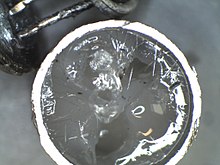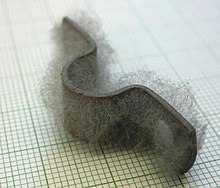Whisker (crystallography)
Whisker ( English for Whisker ( whiskers ) or whiskers ), also whiskers are acicular single crystals of a few microns in diameter and up to several hundred microns to several millimeters in length, consisting of electrically or pyrolytically outgrow deposited metallic layers. In the field of soldered connections, whiskers with a length of several millimeters are known.
However, whiskers are also specifically manufactured using special process technologies for reinforcing metals ( metal matrix composite material ). They are fine, high-strength, monocrystalline fibers that have a low defect density and thus reach the theoretical yield point. They are available in a fineness of 1–30 µm and a fiber length of up to 20 mm z. B. made of aluminum oxide, graphite, silicon carbide and silicon nitride.
Whisker tendency of the materials
Some materials have an increased tendency to form whiskers. This includes, for example, antimony , cadmium , indium , zinc and tin .
Since whiskers are single crystals, they have a very homogeneous structure, almost free from crystal defects . Screw dislocations , for example, can occur as crystal defects . Whiskers have much higher strengths than polycrystalline structures. Ceramic cutting materials , for example, are mixed with SiC whiskers in order to increase wear resistance.
Whisker growth is a dynamic process with numerous possibilities for influencing it. The length growth of the whiskers can be up to 3 mm per year.
Whiskers in electronic assemblies
Whisker growth

In assemblies, whiskers sometimes only develop after years of operation. Here the beginning danger cannot be measured from the outside. The whisker only has an impact when there is an electrical connection between two electrical networks.
When whiskers grow, atoms are transported . The whisker growth occurs more strongly at medium temperatures. At low temperatures, the mobility of the atoms is not so great. At higher temperatures, tensions in the material can be reduced more easily. For tin (part of the solder material) the mean temperature range is between room temperature and 70–80 ° C.
Furthermore, the proportion of tin must be taken into account in the formation of whiskers in a solder alloy. If the tin content of the alloy is less than 70 percent, the whisker growth effect does not occur.
Furthermore, whisker growth occurs to a greater extent on components or circuit boards that are under mechanical stress.
In whisker formation, a distinction must be made between electrodeposited layers and melted layers. The melted layers generally have a lower probability of whisker formation.
Consequences of whisker formation
The current carrying capacity of the whiskers is in the mA range and can be up to 10 mA. In the case of larger currents, the whiskers often burn out again, but by then the current that has flowed may have led to component damage or malfunctions.
Whiskers develop particularly easily in assemblies that have been processed with lead-free tin solders and can cause short circuits on electroplated printed circuit boards or between components. In safety-critical electronics applications , for example ABS or ESP systems in motor vehicles, solders containing lead are still used because of the lack of long-term stability, since this is the only way to prevent whisker formation. With the introduction of the new end-of-life vehicle ordinance , which prohibits the use of lead-containing materials, lead-free soldering processes are mandatory for all car electronics.
Suppression of whisker growth
The whisker growth can be largely suppressed by applying intermediate layers. Nickel is often used here as an intermediate layer. In order for this intermediate layer to be effective, it must have a minimum thickness of 3 µm. Gold and silver can also be used as additional materials for intermediate layers .
In general, electroplated layers tend to develop whiskers. The use of hot applied layers can minimize the risk of whisker formation. Furthermore, there is an improvement if galvanically applied layers are subsequently melted on.
Furthermore, whisker formation can be minimized by minimizing the mechanical stresses applied to the circuit boards and assemblies. This also includes mechanical forces on clamp and screw connections in assemblies.
By using lead-containing solder materials instead of lead-free solder materials, the risk of whisker growth can be minimized. In lead-containing solder, the proportion of tin is often in the region of 60 percent, while the proportion of tin in lead-free solders is well over 90 percent.
Coating the circuit board with a conformal coating, which is supposed to protect against moisture and dirt, can slow down the growth of whiskers, but not prevent it.
Whisker production
For the generation of whiskers, growth from supersaturated gases, from solutions through chemical decomposition, through electrolysis, from melts or from solids can be used, whereby catalysts are usually necessary. Whiskers can grow from both the base and the top. Among a large number of whisker compositions, silicon carbide and Si 2 N 2 whiskers have proven particularly suitable for reinforcing metals.
literature
- Reinard J. Klein Wassink: Soft soldering in electronics . 2nd Edition. Eugen G. Leuze, Saulgau 1991, ISBN 3-87480-066-0 .
- Wolfgang Scheel (Hrsg.): Assembly technology of electronics . Verlag Technik et al., Berlin et al. 1997, ISBN 3-341-01100-5 .
Web links
Individual evidence
- ↑ a b c d e f g h i j k l m n Reinard J. Klein Wassink: Soft soldering in electronics. 1991, p. 305 f.
- ↑ Eberhard Hornbogen, Gunther Eggeler, Ewald Werner: Materials - Structure and properties of ceramic, metal, polymer and composite materials . 11th, updated edition. Springer Verlag, Berlin 2017, p. 458.
- ↑ Hans-J. Koslowski: Chemical fiber - Lexicon. 12th, expanded edition, Deutscher Fachverlag, Frankfurt am Main 2009, ISBN 978-3-87150-876-9 , p. 248.
- ↑ KU Kainer: Metallic composite materials. WILEY-VCH Verlag, Weinheim 2003, ISBN 3-527-30532-7 , p. 85.
- ↑ a b Reinard J. Klein Wassink: Soft soldering in electronics. 1991, p. 162 f.
- ^ Jong S. Kadesch, Jay Brusse: The Continuing Dangers of Tin Whiskers and Attempts to Control Them with Conformal Coating. 2001, (PDF; 434 kB).
- ↑ KU Kainer: Metallic composite materials. WILEY-VCH Verlag, Weinheim 2003, ISBN 3-527-30532-7 , p. 86.

